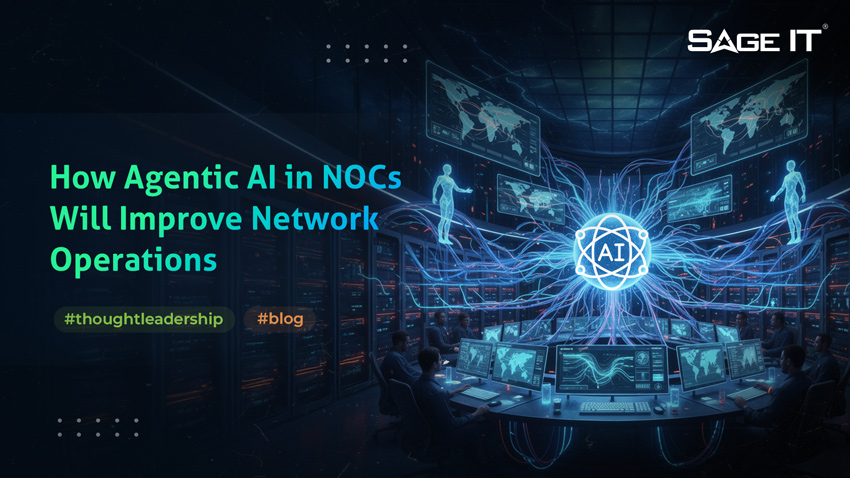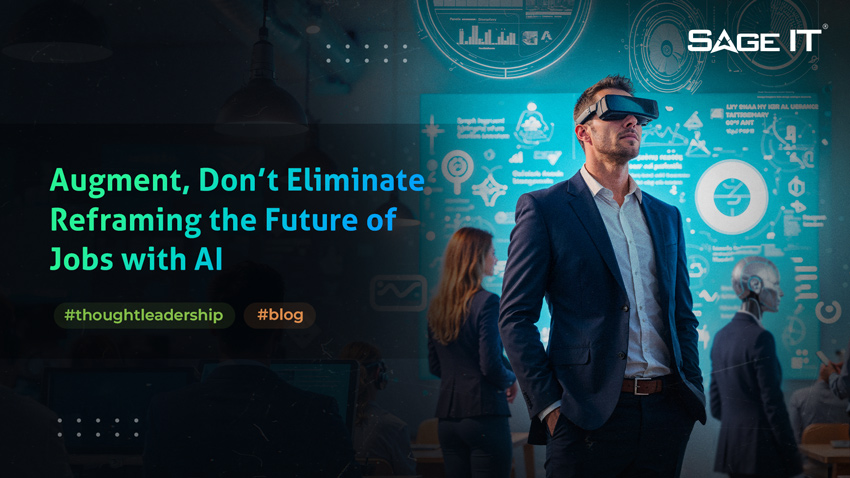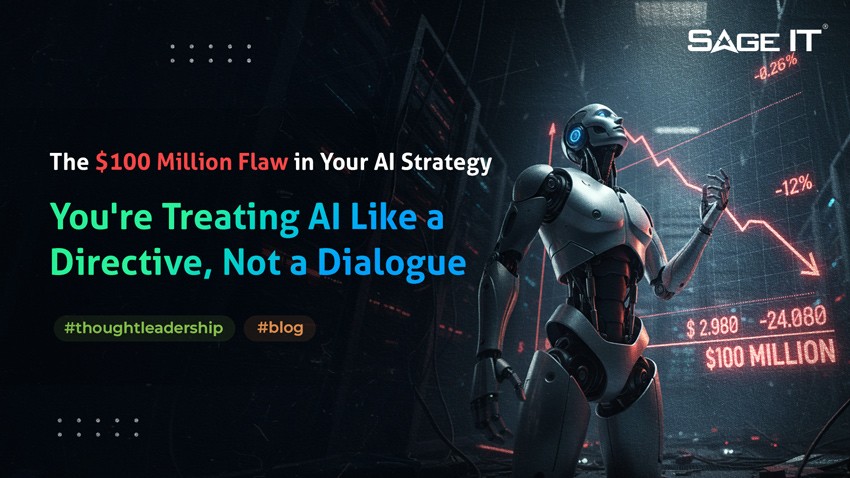Modern NOCs are drowning in complexity. Networks now handle millions of connections and generate over 3,800 terabytes of data every minute, unstructured, fast, and relentless. Add IoT, 5G/6G slicing, hybrid cloud, and edge, and the challenge multiplies. Traditional automation can’t keep up, leaving operators buried in alerts, with critical issues often lost in the noise.
To solve this problem, NOCs can use Agentic AI, which applies sophisticated reasoning and iterative planning to move beyond simple automation and create truly self-healing, adaptive systems. Instead of just executing a pre-defined script in response to an alert, Agentic AI can understand context and devise a multi-step plan to resolve it.
Agentic AI in NOCs: Why It Matters Now

The Pressure on Current NOCs
If current AI automation in a NOC is like following a fixed checklist for every alert, agentic AI is like having an experienced operator who understands the entire network, adapts to unexpected conditions, and keeps services running even when critical systems fail.
In technical terms, agentic AI refers to artificial intelligence systems with agency, the ability to act independently, make context-based decisions, and carry out tasks with minimal human oversight. These are not static scripts or pre-programmed workflows. They are intelligent agents that can observe, reason, act, and learn within the complex environment of a modern network.
This is the critical difference from legacy automation:
- Automation executes instructions
- Agentic AI interprets situations, chooses actions, and adapts to outcomes.
In a Network Operations Center, this means moving from “if X happens, run Y script” to “detect anomalies, evaluate context, predict outcomes, and decide the best course of action, even if it wasn’t pre-defined.”
Think of Generative AI as the strategist, capable of modeling, simulating, and advising, while agentic AI is the executor, the hands and limbs that actually reconfigure devices, reroute traffic, patch vulnerabilities, and resolve incidents.
Most importantly, agentic AI is not static. It continuously learns from network history, incident logs, and live events. Over time, it doesn’t just respond faster, it responds smarter, building a self-reinforcing cycle of resilience.
This is why so many enterprises are beginning to frame their vision around self-operating networks. The leap isn’t just technical. It’s philosophical: shifting from networks that depend on constant human supervision to networks that can anticipate, adapt, and act on their own.
How Agentic AI Transforms Network Operations Center (NOC)
The promise of agentic AI in Network Operations Center (NOC) isn’t abstract, it comes alive through specialized agents, each designed to own a critical function of the network. Working together, they address the daily challenges operators face and turn reactive into proactive, autonomous management.
1. Smarter Network Monitoring & Anomaly Detection (Network Health Agent)
Instead of drowning teams in thousands of alerts, the Network Health Agent continuously scans traffic patterns, device logs, and performance metrics to spot anomalies before they escalate.
- Example: Detecting packet loss trending upward in a segment before it impacts end-user experience.
- Benefit: Reduces alert fatigue and ensures operators focus only on meaningful incidents.
2. Predictive Assurance Before Failures Occur (Network Operations Center Agent)
Beyond detection, the NOC Agent provides predictive assurance, analyzing data to forecast failures and act in advance.
- Example: Predicting router overload during peak streaming hours and reallocating bandwidth proactively.
- Benefit: Moves NOCs from reactive to proactive resilience, preventing costly downtime.
3. Dynamic Traffic Optimization (Network Optimization Agent)
Modern networks need agility to handle sudden spikes in demand. The Network Optimization Agent continuously rebalances resources to keep services running smoothly.
- Example: Rerouting traffic during a stadium event to avoid congestion, ensuring low latency for both live streams and local services.
- Benefit: SLA compliance, smoother customer experience, and fewer manual interventions.
4. Security Co-Pilots for Real-Time Defense (Network Configuration Agent)
Security is no longer siloed; it’s built into network operations. The Network Configuration Agent enforces adaptive policies to defend against evolving threats.
- Example: Detecting a data flow resembling a DDoS attack, automatically updating firewall rules, and isolating the threat in seconds.
- Benefit: Continuous protection against fast-moving cyberattacks without waiting for human escalation.
5. Automated Incident Resolution & Self-Healing Networks (NOC + ONAP Agents)
When failures happen, multiple agents collaborate to diagnose and fix issues autonomously.
- Example: A failing router port is identified, a ticket raised, solutions proposed, and a recovery action (such as a reboot) executed, all logged for future learning.
- Benefit: Significant reduction in Mean Time to Resolution (MTTR) and minimized business disruption.
6. Continuous Learning for Future Resilience (Knowledge Base Agent)
Every resolution becomes knowledge for the next challenge. The Knowledge Base Agent draws from past incidents, documentation, and operator feedback to refine responses.
- Example: An outage fixed once becomes part of the AI’s playbook, ensuring faster, more accurate remediation next time.
- Benefit: Networks evolve into self-learning ecosystems, steadily improving resilience.
7. Enabling Long-Term Agility (Network Planning & Slicing Agents)
Beyond day-to-day operations, some agents focus on future readiness:
- The Network Planning Agent analyzes usage trends and forecasts capacity needs to guide infrastructure investment.
- The Network Slicing Agent manages 5G/6G slices, ensuring mission-critical services like healthcare or finance remain isolated and compliant with SLAs.
- Benefit: Scalable, future-proof networks that adapt to business priorities and user expectations.
Together, these agents address core NOC functions, but their true power emerges when agentic AI orchestrates them into one adaptive system. Acting as the conductor, it delivers end-to-end visibility, predictive assurance, and zero-touch resolution, evolving the NOC into a resilient, self-sustaining command center that continuously learns and safeguards customer experience.
Adoption Barriers and What Enterprises Must Do First
The shift toward agentic AI in Network Operations isn’t as simple as deploying a new tool. Enterprises that want to move from reactive to self-operating networks must first address structural and cultural barriers that stand in the way.
1. Interoperability: Breaking Down Vendor Silos
Most enterprises operate in a patchwork of multi-vendor environments, routers, switches, SD-WAN, cloud platforms, and security tools that were never designed to communicate seamlessly.
For agentic AI to function, these systems must expose API-friendly architectures that allow agents to share data and act consistently across domains. Without interoperability, intelligence gets trapped in silos.
2. Tool Consolidation: Reducing the Noise
On average, enterprises juggle 50 or more monitoring tools. While each provides visibility into a slice of the infrastructure, the result is duplication, alert fatigue, and missed context.
Before deploying AI agents, organizations should collapse fragmented monitoring stacks into unified observability platforms that surface only what matters.
Consolidation not only improves signal-to-noise ratio but also gives AI a coherent dataset to act on.
3. Governance: Building Trust Through Responsible AI
Handing control of network operations to autonomous agents raises critical questions: Can we trust these systems? How do we hold them accountable? Enterprises must establish frameworks for responsible AI, including:
- Explainability, the ability to trace why an agent took a specific action.
- Accountability, clear human oversight and escalation paths.
- Compliance, alignment with security, privacy, and regulatory requirements.
Governance isn’t just a technical safeguard; it’s the trust mechanism that ensures operators and executives alike are confident in AI-driven decisions.
4. Upskilling: Preparing the Workforce for Co-Working with AI
The workforce challenge is just as important as the technical one. Network engineers aren’t being replaced, they’re being elevated. To succeed, organizations must retrain staff to collaborate with AI agents, focusing on roles such as:
- Designing guardrails and policies.
- Validating AI-led recommendations.
- Managing exceptions and strategic escalations.
The Vision: Toward Self-Operating Networks
The complexity of modern networks is outpacing human capacity. Traditional NOCs, built for static environments, are overwhelmed by the volume of data, the diversity of technologies, and the demand for seamless performance.
Agentic AI is the bridge to a new era, enabling intelligent agents that deliver zero-touch resolution, predictive assurance, and end-to-end visibility across multi-domain environments. These agents don’t just react; they continuously learn, adapt, and collaborate to keep networks resilient, optimized, and secure.
The future is a self-operating network: one that is proactive, adaptive, and self-healing. A network that can reduce downtime, enhance customer experience, and sustain performance at scale.
The NOC of tomorrow won’t simply observe problems. It will anticipate them, resolve them autonomously, and evolve in step with business and user needs.
How to Get Started with Agentic AI in Your Network Operations
The path to a self-operating NOC begins with clarity: define outcomes such as reducing downtime, accelerating resolution, or freeing engineering talent for higher-value work. Next, identify high-friction workflows where manual intervention, alert fatigue, or tool sprawl expose the business to risk, these are the best candidates for agentic AI pilots.
But here’s the reality: without expertise, most enterprises lose months in trial-and-error, struggling with integration, governance, and cultural adoption. At Sage IT, our AI consulting support removes that friction, providing a proven framework to deploy agents responsibly, align with business priorities, and accelerate value capture.
FAQs
Agentic AI delivers measurable ROI by reducing downtime costs, improving SLA compliance, and cutting alert fatigue. Enterprises gain agility, better customer experience, and long-term cost savings through proactive, self-healing networks.
The adoption journey begins with tool consolidation and API-friendly interoperability, followed by implementing governance frameworks and retraining staff. Partnering with experienced AI solution providers accelerates pilots and reduces risk.
Yes, when governed responsibly. Agentic AI uses adaptive policies, explainability, and compliance checks to act safely. With proper guardrails, it can respond faster than humans to evolving threats while maintaining accountability.
Engineers shift from manual troubleshooting to AI collaboration roles: designing guardrails, validating AI decisions, managing exceptions, and ensuring compliance. Upskilling in data analytics, AI operations, and automation strategy becomes essential.
Industries with high-availability demands, telecom, finance, healthcare, and media/entertainment, see the biggest gains. Agentic AI ensures 24/7 uptime, optimizes bandwidth during spikes, secures sensitive data, and enables personalized, latency-sensitive services.












